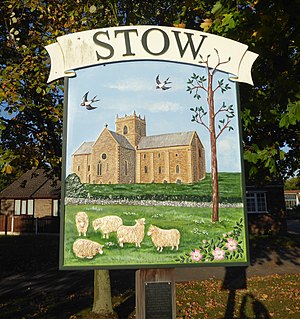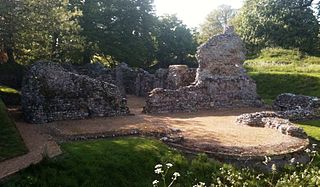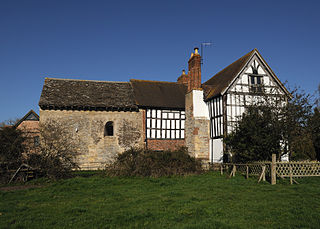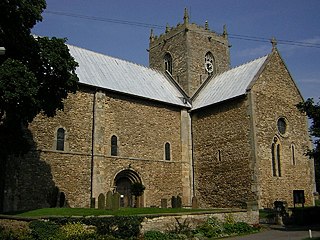
Peterborough Cathedral, properly the Cathedral Church of St Peter, St Paul and St Andrew – also known as Saint Peter's Cathedral in the United Kingdom – is the seat of the Anglican Bishop of Peterborough, dedicated to Saint Peter, Saint Paul and Saint Andrew, whose statues look down from the three high gables of the famous West Front. Although it was founded in the Anglo-Saxon period, its architecture is mainly Norman, following a rebuilding in the 12th century. With Durham and Ely cathedrals, it is one of the most important 12th-century buildings in England to have remained largely intact, despite extensions and restoration.

Anglo-Saxon architecture was a period in the history of architecture in England, and parts of Wales, from the mid-5th century until the Norman Conquest of 1066. Anglo-Saxon secular buildings in Britain were generally simple, constructed mainly using timber with thatch for roofing. No universally accepted example survives above ground.

The term Norman architecture is used to categorise styles of Romanesque architecture developed by the Normans in the various lands under their dominion or influence in the 11th and 12th centuries. In particular the term is traditionally used for English Romanesque architecture. The Normans introduced large numbers of castles and fortifications including Norman keeps, and at the same time monasteries, abbeys, churches and cathedrals, in a style characterised by the usual Romanesque rounded arches and especially massive proportions compared to other regional variations of the style.

The Bishop of Norwich is the ordinary of the Church of England Diocese of Norwich in the Province of Canterbury. The diocese covers most of the county of Norfolk and part of Suffolk. The bishop of Norwich is Graham Usher.
This article describes the history of Suffolk, the English county.

Norwich Cathedral is an Anglican cathedral in Norwich, Norfolk, dedicated to the Holy and Undivided Trinity. It is the cathedral church for the Church of England Diocese of Norwich and is one of the Norwich 12 heritage sites.

Stow is a small village and civil parish within the West Lindsey district of Lincolnshire, England. It is 11 miles (18 km) north-west of the city of Lincoln and 6 miles (10 km) south-east of Gainsborough, and lies along the B1241 road. The total resident population was 355 at the 2001 census, increasing to 365 at the 2011 census.

North Elmham is a village and civil parish in the English county of Norfolk. It covers an area of 7.41 sq mi (19.2 km2) and had a population of 1,428 in 624 households at the 2001 census, including Gateley and increasing slightly to 1,433 at the 2011 Census. For the purposes of local government, it falls within the Elmham and Mattishall division of Norfolk County Council and the Upper Wensum ward of Breckland District Council. The village is located along the B1145 a route which runs between King's Lynn and Mundesley.

Norfolk is a rural county in the East of England. Knowledge of prehistoric Norfolk is limited by a lack of evidence — although the earliest finds are from the end of the Lower Paleolithic period. Communities have existed in Norfolk since the last Ice Age and tools, coins and hoards such as those found at Snettisham indicate the presence of an extensive and industrious population.

Wolvesey Castle, also known as the "Old Bishop's Palace", is a ruined building in Winchester, Hampshire, England that was a bishop's palace, and was briefly fortified during the later years of Henry of Blois, the Bishop of Winchester. The first building on the site, an eyot in the River Itchen known as Wulveseye or Wulf's island, was constructed around 970 by Æthelwold of Winchester, the Bishop of Winchester from 963 to 984, as his official residence or palace. Winchester came under siege during the Rout of Winchester in 1141 by the Empress Matilda during the period of civil war known as The Anarchy, and held out for three weeks until relieved by Stephen's wife, Matilda. Subsequently Henry, the brother of Stephen, King of England, enlarged and fortified the palace by building a curtain wall, giving the palace the appearance of a castle. The fortifications were slighted by Henry II after the death of Henry in 1171.

All Saints and St Nicholas, South Elmham is a civil parish in the north of the English county of Suffolk. It is 5 miles (8.0 km) south of the market town of Bungay and the same distance north-west of Halesworth and east of Harleston. The parish is in the East Suffolk district and is one of the parishes that make up the area around Bungay known as The Saints. It includes the settlements of All Saints, South Elmham and St Nicholas, South Elmham.

The Church of St Martin is an ancient Church of England parish church in Canterbury, England, situated slightly beyond the city centre. It is recognised as the oldest church building in Britain still in use as a church, and the oldest parish church in the English-speaking world, although Roman and Celtic churches had existed for centuries. The church is, along with Canterbury Cathedral and St Augustine's Abbey, part of a World Heritage Site.

Pevensey Castle is a medieval castle and former Roman Saxon Shore fort at Pevensey in the English county of East Sussex. The site is a scheduled monument in the care of English Heritage and is open to visitors. Built around 290 AD and known to the Romans as Anderitum, the fort appears to have been the base for a fleet called the Classis Anderidaensis. The reasons for its construction are unclear; long thought to have been part of a Roman defensive system to guard the British and Gallic coasts against Saxon pirates, it has more recently been suggested that Anderitum and the other Saxon Shore forts were built by a usurper in an ultimately unsuccessful attempt to prevent Rome from reimposing its control over Britain.

Odda's Chapel is a former chantry chapel at Deerhurst, Gloucestershire. It is an 11th-century late Anglo-Saxon building, completed a decade before the Norman Conquest of England.

St John the Baptist's Church is the former cathedral of Chester, Cheshire, England during the Early Middle Ages. The church, which was first founded in the late 7th Century by the Anglo Saxons, is outside Chester's city walls on a cliff above the north bank of the River Dee. It is now considered to be the best example of 11th–12th century church architecture in Cheshire, and was once the seat of the Bishop of Lichfield from 1075 to 1095.

The medieval cathedrals of England, which date from between approximately 1040 and 1540, are a group of twenty-six buildings that constitute a major aspect of the country’s artistic heritage and are among the most significant material symbols of Christianity. Though diverse in style, they are united by a common function. As cathedrals, each of these buildings serves as central church for an administrative region and houses the throne of a bishop. Each cathedral also serves as a regional centre and a focus of regional pride and affection.

The Minster Church of St Mary, Stow in Lindsey, is a major Anglo-Saxon church in Lincolnshire and is one of the largest and oldest parish church buildings in England. It has been claimed that the Minster originally served as the cathedral church of the diocese of Lindsey, founded in the 7th century and is sometimes referred to as the "Mother Church of Lincolnshire".

St Peter's Church is in the village of Heysham, Lancashire, England. It is recorded in the National Heritage List for England as a designated Grade I listed building. It is an active Anglican parish church in the deanery of Lancaster, the archdeaconry of Lancaster and the diocese of Blackburn.

The Abbey Church of Saint Peter and Saint Paul, Monkwearmouth–Jarrow, known simply as Monkwearmouth–Jarrow Abbey, was a Benedictine double monastery in the Kingdom of Northumbria, England.

St Cross South Elmham is a village and civil parish in the north of the English county of Suffolk. It is in the East Suffolk district, close to the border with Norfolk and is 3 miles (4.8 km) east of Harleston and 4.25 miles (6.84 km) south-west of Bungay. It is one of the villages around Bungay known as the Saints.




















